Spessartine Garnet
Orange to dark brownish-red garnet.
Forms a series with Almandine and Pyrope (Pyralspite Series)
Contrary to pyrope or almandine, spessartine is quite rare. As a species of its own spessartine has only been recognized at the end of the 19th century. In early gemmological literature spessartine is not mentioned, partly because the deposits were not yet known, partly because the few specimens that were found were mis-identified as hessonite garnet, the orange to (brownish-) red variety of grossular.
Spessartine Garnet shop
Origin of name: after the first location in the German Spessart Mountains, near the town of Aschaffenburg.
Synonyms and trade names: formerly called spessartite. Today most orange, reddish orange or orngered garnets are marketed as mandarine garnets. Originally this term was exclusively used for the spectacular spessartines from Namibia.
Can be confused with: all orange to brownish-red gemstones like citrine, zirkon, sapphire or sphene (titanite). To distinguish garnet from any of those gems is quite simple as garnet is singly refractive.
Distinction between hessonite and spessartine is fairly straightforward, too. Hessonite has a refractive index of 1.731 to 1.754 whereas the R.I. of spessartine lies between 1.795 and 1,985 which is beyond the range of a standard refractometer. Hessonite can also be identified by its typical inclusions. Most hessonites sport a plethora of tiny apatite crystals as well as a diagnostic appearance through the loupe which in gemmological literature very aplty is described as "oily" or "treacle".
The distinction between spessartine and almandine poses a greater challenge because refractive indizes overlap. The study of their inclusions is not always helpful, firstly because many spessartines are of very high clarity and secondly because the frequently encountered "fingerprints" are common in in both species. Identification can be achieved by the typical absorption spectrum of almandine.
However, almandine and spessartine form a series, which further complicates the matter. So, if you need to know exactly, you have to resort to some kind of element analysis.
Localities: the first locality in the Spessart never reached commercial importance.
There are several small deposits in the USA. Probably the best known mine is the Rutherford Mine in Virginia which was operative from 1883 to 1960. Apart from spessartine this mine also yielded gem quality amazonite feldspar and mica.
Other mines, partly still operative today, are located in San Diego County, California.
India and Sri Lanka also produce spessartines. In the 1960ies considerable quantities of beautifully colored but very heavily included material was found near Mumbai (formerly Bombay).
In 1991 orange garnets of unseen colour and luminosity were discovered at the banks of the Kunene River between Namibia and Angola. The outstanding quality of these stones immediately captured the gem community. At first the new stones were termed "hollandine", after the family colour of the Netherland Royals (Oranje). Later the name mandarin garnet took hold because allegedly in ancient China only high ranking officials, the mandarines, were allowed to wear orange.
There were only two small deposits of mandarine garnet which unfortunately were mined for a few years only. In 1998 both mines were closed. Once again an old Namibian miner's word had come true: Namibia is rich in poor gem deposits…
Rumours that mandarin garnet can also be found on the Angolan side of the Kunene are true but it seems as if nobody is interested in actually minig them.
Now and again there were attempts to re-animate the mines on the Namibian side. Alas, so far all have failed for various reasons. The deposits are 1.500km from the capital Windhoek. There are no roads and the terrain is so difficult that very often it cannot even be mastered by four-wheel drive. Another problem is tensions between mine workers from other parts of the country and the local tribes and last but not least competition from cheaper and bigger Nigerian spessartines is too stiff, even though their colour really is no match for Namibian mandarines.
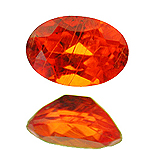
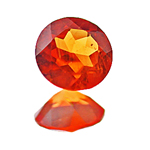
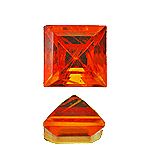
The famous mandarin garnets of Namibia
Madagascar also has spessartines. These usually are of high clarity but unfortunate colour, the high almandine content producing an undesirable brownish tinge.
In April 1999 spessartine was found in Nigeria. The first stones were of rather unattractive brownish tone and heavily included. The international gem community´s disappointment turned to enthusiasm when after about half a year spessartines of bright orange colour, good clarity and large size started to be mined.
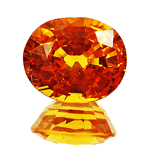
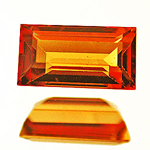
Two spessartines from Nigeria
Handling: sensitive to heat, acids and salts. No borax!
Worth knowing: spessartine is idiochromatic which means that the chromophore (colouring agent) – in this case manganese – is part of the chemical formula. The higher the almandine content (and with it the iron content), the darker and more brownish/reddish the colour.
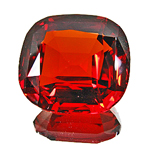
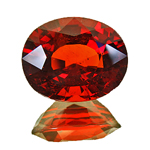
Two Nigerian spessartines with high almandine content
Spessartine Garnet shop
 Deutsch
Deutsch